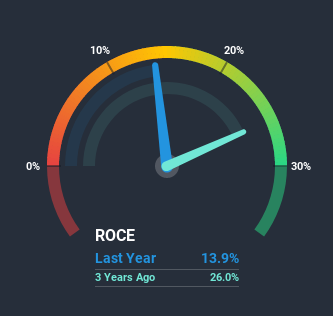Here's What's Concerning About Ingevity's (NYSE:NGVT) Returns On Capital
If you're looking for a multi-bagger, there's a few things to keep an eye out for. Amongst other things, we'll want to see two things; firstly, a growing return on capital employed (ROCE) and secondly, an expansion in the company's amount of capital employed. Put simply, these types of businesses are compounding machines, meaning they are continually reinvesting their earnings at ever-higher rates of return. In light of that, when we looked at Ingevity (NYSE:NGVT) and its ROCE trend, we weren't exactly thrilled.
Understanding Return On Capital Employed (ROCE)
If you haven't worked with ROCE before, it measures the 'return' (pre-tax profit) a company generates from capital employed in its business. Analysts use this formula to calculate it for Ingevity:
Return on Capital Employed = Earnings Before Interest and Tax (EBIT) ÷ (Total Assets - Current Liabilities)
0.14 = US$293m ÷ (US$2.3b - US$223m) (Based on the trailing twelve months to December 2020).
Therefore, Ingevity has an ROCE of 14%. In absolute terms, that's a satisfactory return, but compared to the Chemicals industry average of 7.2% it's much better.
Check out our latest analysis for Ingevity
In the above chart we have measured Ingevity's prior ROCE against its prior performance, but the future is arguably more important. If you'd like, you can check out the forecasts from the analysts covering Ingevity here for free.
The Trend Of ROCE
In terms of Ingevity's historical ROCE movements, the trend isn't fantastic. Around five years ago the returns on capital were 24%, but since then they've fallen to 14%. Meanwhile, the business is utilizing more capital but this hasn't moved the needle much in terms of sales in the past 12 months, so this could reflect longer term investments. It's worth keeping an eye on the company's earnings from here on to see if these investments do end up contributing to the bottom line.
The Bottom Line
Bringing it all together, while we're somewhat encouraged by Ingevity's reinvestment in its own business, we're aware that returns are shrinking. Additionally, the stock's total return to shareholders over the last three years has been flat, which isn't too surprising. Therefore based on the analysis done in this article, we don't think Ingevity has the makings of a multi-bagger.
If you'd like to know about the risks facing Ingevity, we've discovered 1 warning sign that you should be aware of.
For those who like to invest in solid companies, check out this free list of companies with solid balance sheets and high returns on equity.
This article by Simply Wall St is general in nature. It does not constitute a recommendation to buy or sell any stock, and does not take account of your objectives, or your financial situation. We aim to bring you long-term focused analysis driven by fundamental data. Note that our analysis may not factor in the latest price-sensitive company announcements or qualitative material. Simply Wall St has no position in any stocks mentioned.
Have feedback on this article? Concerned about the content? Get in touch with us directly. Alternatively, email editorial-team (at) simplywallst.com.

